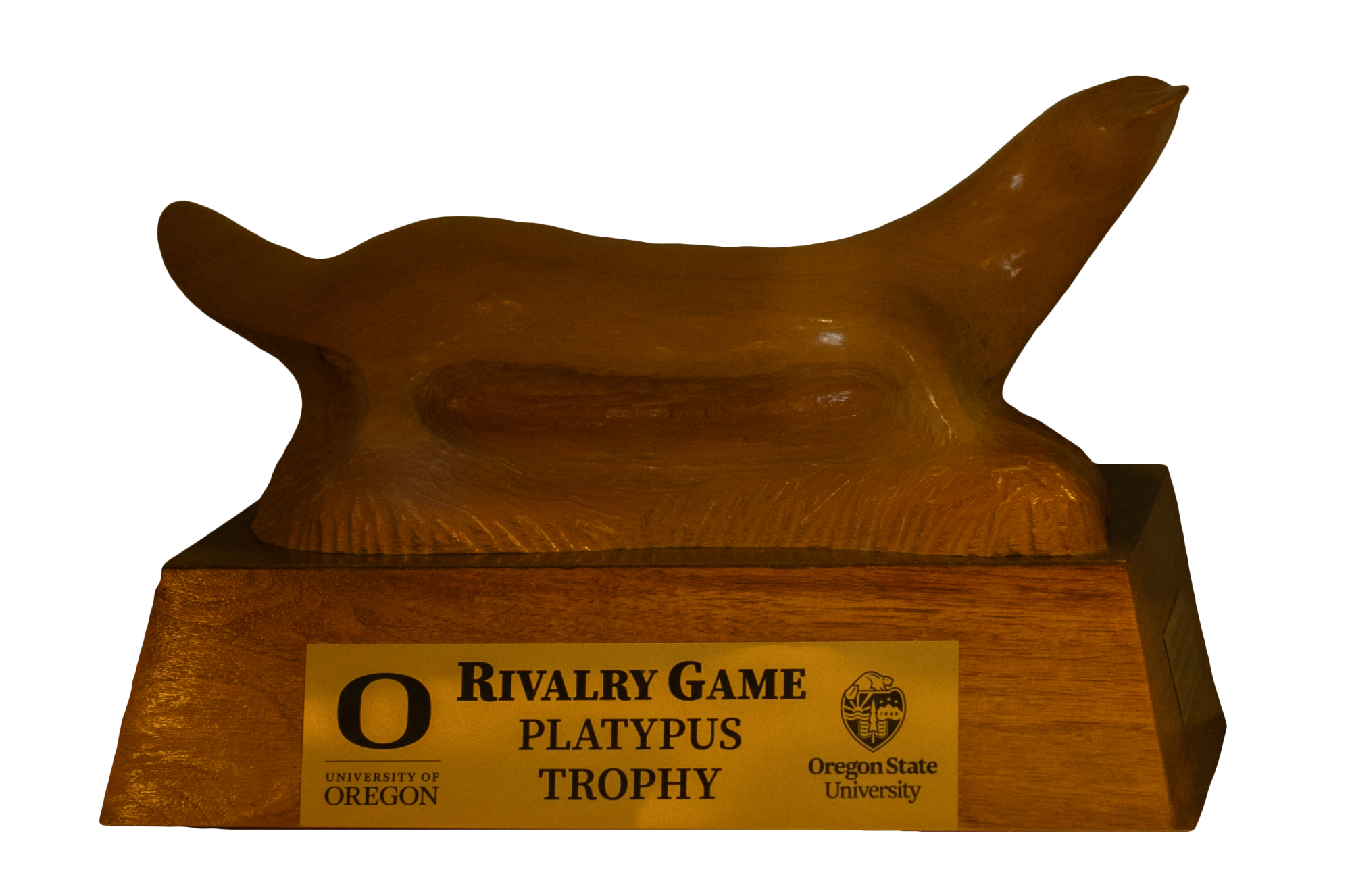From earning the infamous Platypus Trophy to kidnapping the homecoming court, traditions have played a significant role in Oregon State University football throughout the years. Traditions have even more importance with the arrival of the notorious rivalry game between the Oregon State Beavers and the University of Oregon Ducks on Nov 24.
Senior Associate Athletic Director at Oregon State University, Sara Elcano, stated in an email interview, “Stadium-wide traditions are important because they transform you from an individual fan to part of a larger family. Sports have the ability to bring people together like nothing else, and traditions serve to enhance that comradery.”
With the 2023 football season in full effect, new and old traditions have found their way into the hearts of all Beavers fans, but how did we create such traditions, and how have they changed over the years?
Destroying the O
Featured in Skinner Butte Park in Eugene is the “Big O.” This yellow-painted O was first built in 1908, and many generations of the O have been built since then. Surrounding the rivalry game, the Big O has been tormented by kidnappings, fires, explosions, and paintings.
“OSU students burned the big yellow O on at least one occasion or painted it orange,” said Larry Landis, an archivist who worked nearly 30 years at Oregon State University.
The Big O is now composed of thick plate steel embedded in reinforced concrete to minimize the damage of the many pranks performed by OSU students. The Big O that stands today has reportedly been painted over 200 times due to the antics of Beaver Fans, as reported by the Skinner’s Butte information page.
Throwing of the Hat
A long-forgotten tradition of Beaver football is the throwing of the hat. Corvallis resident John Richard Newton Bell, a Presbyterian minister, became a well-known member of the Beaver community, being nicknamed the “human mascot.” Bell earned fame after throwing his hat into the Marys River after each OSU win in the rivalry game.
The throwing of the hat tradition first started in the year 1894, and the event grew into one of the most anticipated social events in Corvallis.
“You would have hundreds of townspeople tagging along to watch him throw it in,” said Kip Carlson, a former employee at OSU’s Sports Information Office from 1996 to 2007 and sports writer at the Corvallis Gazette-Times from 1991 to 1996.
“A History of Athletic Mascots at Oregon State University,” published by the OSU Alumni Association, explains that in the 1920s, to honor Bell’s devotion to Oregon State Athletics, the football field previously known as “The College Field” was named “Bell Field.” The field continued to be named after the local legend until 1951 when it was replaced by Parker Stadium (now Reser Stadium).
Hijinks
Countless hijinks have been performed throughout the history of the rivalry game. Some of those pranks, such as painting the “Big O,” can be considered harmless.
“One of the things I always liked, and it was fun to read when I was in high school and college … was the schools would do parodies of each other’s newspaper,” Carlson said, reflecting on traditions.
Students would copy the format of the other school’s newspaper and write articles that made fun of their athletics or academics. Students would then drop off copies at their respective schools for community members to find.
Many argue that other tricks can sometimes go too far, including one stunt described in the article “Civil War: 5 moments that fanned the flames of the rivalry” by the Oregonian where in 1957, Oregon’s Theta Xi fraternity impersonated reporters and kidnapped the women of OSU’s homecoming court, stashing them at a parent’s house and sending ransom notes to the student body president of OSU.
Pregame Festivities
Some may argue that the moments before the game are more important than the game itself, and what these folks are referring to is tailgating. Tailgating dates back to before Beaver football existed and has been a prevalent and pivotal part of the Beaver community.
Tailgating is a common tradition where sports fans gather outside Reser Stadium to hang out, drink, eat, and prepare themselves for the game ahead. Activities such as barbequing, playing cornhole, and singing chants are all welcomed as the timer ticks down to the start of the game.
Fans also participate in the Beaver Walk, in which they cheer athletes on as they get off the bus and prepare for battle. “Fans would gather as the players got off the bus to enter the stadium on game day,” Landis said.
Hundreds to thousands of fans would cheer on their soldiers with signs, chants, and more. Oregon State Beavers fans occasionally crowd around the University of Oregon bus, booing and spewing hateful comments.
Oregon State Marching Band
Another long-lasting tradition shining within its Oregon State Football glory is the OSU Marching Band.
“One of the things I think is the most enduring … is the marching band,” said Landis. “The band program dates to 1891, so it is the oldest band program in the PAC-12 conference.”
The Oregon State University Marching Band is commonly known as the Spirit and Sound of OSU, the band playing in front of more than 50,000 Beaver football fans at Reser Stadium and providing an electric atmosphere that fans can build off of.
Platypus Trophy
The Platypus Trophy highlighting both Beaver and Duck features originated in 1959 and was designed by Warren Spady, a University of Oregon art student.
The Platypus Trophy was awarded to the winner of the rivalry game each year, continuing until 1961, before it disappeared. It was a common tradition for OSU or UO students to attempt to steal the trophy from each other.
After a 40-year disappearance, the Platypus Trophy was finally discovered in 2005. Since 2007, the trophy has been awarded to the alumni association of the winning school for safekeeping and to prevent another disappearance.
The trophy’s whereabouts during its 40-year disappearance are unknown, and many speculations have been made about how it was rediscovered. Those speculations include the original artist Warren Spady noticing the trophy within a trophy case at UO’s Leighton Pool and an Oregon State janitor discovering the trophy within a janitorial closet at OSU’s Athletics Department.
The Bronze Beaver
“There was a football coach named Jerry Pettibone in the early 1990s who wanted to introduce some traditions to OSU football in general, and one of them was the Bronze Beaver,” Carlson said. A large bronze statue of a beaver was made and placed at the end of the ramp entering the Valley Football Center where the rivalry game was played.
Approaching the rivalry game, pranks and other antics took a toll on the Bronze Beaver, and in efforts to protect the statue from University of Oregon students, Oregon State would employ the help of their own community. “They would have students stand watch over the Bronze Beaver,” Carlson said.
Chainsaw on Third Down
Chainsaw noises pang out into Reser Stadium to prepare for a defensive block and to psych out the opponent team’s members. Deafening noises are coupled with the mimicking of starting a chainsaw from OSU students and community members.
“Every fan has their own opinion on this, but after 13 football seasons that I’ve worked at Oregon State, the chainsaw on third down remains my favorite. That noise is music to the ears of Oregon State fans and our student-athletes, and annoying to the opponent – just as it should be,” said Elanco.
The end of a tradition?
As the rivalry between Oregon State University and the University of Oregon falls into uncharted territory due to the disassembling of the PAC-12 conference, the use of traditions to encourage athletics continues to thrive, supporting the football community even in rocky times.
“The support of Beaver Nation in Reser Stadium, enhanced by traditions, is noticed by our football program,” Elanco said. “Reser Stadium is a tough place to play right now thanks to the support — and noise — that our fans provide!”













































































































